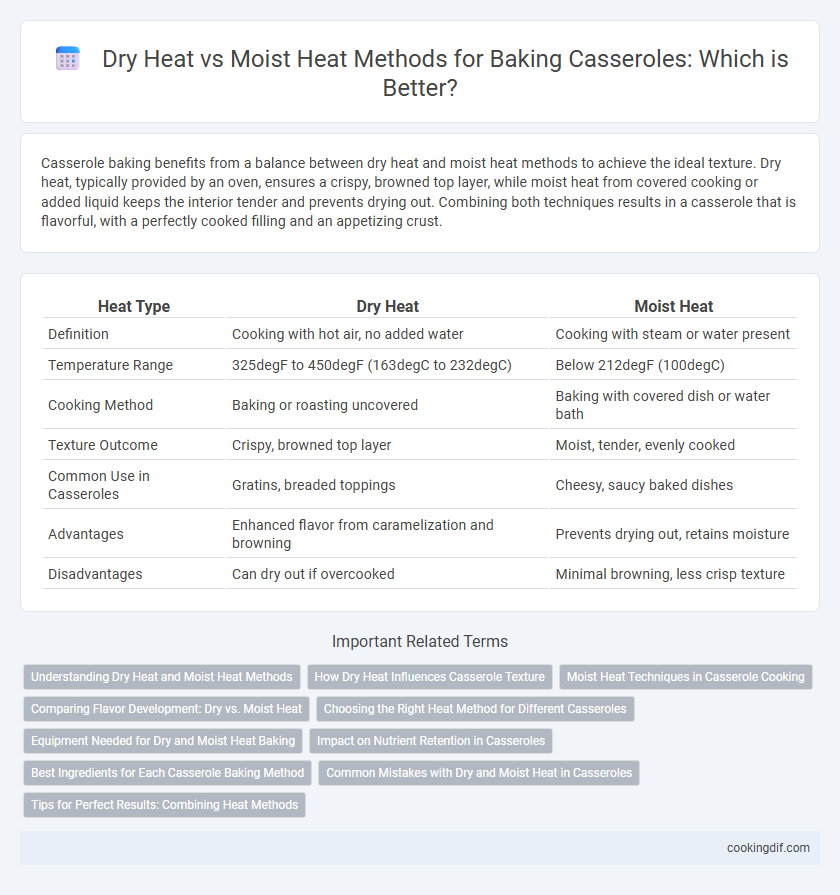Casserole baking benefits from a balance between dry heat and moist heat methods to achieve the ideal texture. Dry heat, typically provided by an oven, ensures a crispy, browned top layer, while moist heat from covered cooking or added liquid keeps the interior tender and prevents drying out. Combining both techniques results in a casserole that is flavorful, with a perfectly cooked filling and an appetizing crust.
Table of Comparison
| Heat Type | Dry Heat | Moist Heat |
|---|---|---|
| Definition | Cooking with hot air, no added water | Cooking with steam or water present |
| Temperature Range | 325degF to 450degF (163degC to 232degC) | Below 212degF (100degC) |
| Cooking Method | Baking or roasting uncovered | Baking with covered dish or water bath |
| Texture Outcome | Crispy, browned top layer | Moist, tender, evenly cooked |
| Common Use in Casseroles | Gratins, breaded toppings | Cheesy, saucy baked dishes |
| Advantages | Enhanced flavor from caramelization and browning | Prevents drying out, retains moisture |
| Disadvantages | Can dry out if overcooked | Minimal browning, less crisp texture |
Understanding Dry Heat and Moist Heat Methods
Dry heat methods for casseroles involve baking in an uncovered dish, allowing hot air to circulate and create a browned, crispy top layer. Moist heat methods utilize covered baking with steam trapped inside, resulting in tender, evenly cooked ingredients without drying out. Understanding these techniques enables precise texture control, balancing crust formation with internal moisture retention for optimal casserole results.
How Dry Heat Influences Casserole Texture
Dry heat in casserole baking promotes a crispy, golden crust by evaporating surface moisture and encouraging Maillard browning reactions. This method enhances texture contrast, giving the casserole a firm, crunchy top layer while maintaining a tender interior. In contrast to moist heat, dry heat ensures a desirable crust formation that improves overall mouthfeel and visual appeal.
Moist Heat Techniques in Casserole Cooking
Moist heat techniques in casserole cooking, such as baking with a covered dish or adding broth, help to retain moisture and prevent drying out during prolonged cooking. Steaming inside the casserole creates a tender texture by allowing flavors to meld and ingredients to cook evenly. This method is essential for casseroles with delicate proteins, vegetables, or rice, ensuring softness and enhanced flavor absorption.
Comparing Flavor Development: Dry vs. Moist Heat
Dry heat baking in casseroles promotes Maillard reactions, enhancing complex, caramelized flavors and a crispy top layer. Moist heat methods such as covering with foil or adding broth retain moisture, resulting in tender textures but milder flavor profiles. Balancing dry and moist heat techniques maximizes both rich taste and desired consistency in casserole dishes.
Choosing the Right Heat Method for Different Casseroles
Choosing the right heat method for casserole baking depends on the ingredients and desired texture; dry heat, such as baking or roasting, creates a crispy, browned top ideal for casseroles with cheese or breadcrumb toppings. Moist heat methods, like covered baking or steaming, help retain moisture and soften dense ingredients like vegetables and beans, preventing dryness. Adjusting between dry and moist heat ensures optimal flavor and texture tailored to each casserole's components.
Equipment Needed for Dry and Moist Heat Baking
Dry heat casserole baking requires equipment such as an oven, baking dishes made from metal, glass, or ceramic, and racks to ensure even heat distribution and crisp browning. Moist heat baking involves using covered casserole dishes or Dutch ovens that trap steam, often necessitating the use of water baths or steam ovens to maintain humidity. Selecting appropriate cookware influences the texture and moisture retention of the casserole during the cooking process.
Impact on Nutrient Retention in Casseroles
Dry heat methods such as baking typically preserve more nutrients in casseroles by reducing nutrient leaching compared to moist heat techniques like steaming or boiling. Moist heat can cause water-soluble vitamins, including vitamin C and B-complex vitamins, to leach into cooking liquids, decreasing the overall nutrient content of the casserole. Consequently, dry heat baking helps maintain the nutritional integrity of ingredients while enhancing flavor and texture.
Best Ingredients for Each Casserole Baking Method
Dry heat casserole baking works best with ingredients like cheese, breadcrumbs, and meats that benefit from browning and crisp textures, enhancing flavors through caramelization. Moist heat baking favors vegetables, grains, and legumes that absorb liquid, resulting in tender, flavorful dishes with evenly cooked components. Selecting the right baking method depends on the casserole's core ingredients to achieve optimal texture and taste profiles.
Common Mistakes with Dry and Moist Heat in Casseroles
Using dry heat for casseroles often results in uneven cooking and dry edges due to lack of moisture, while excessive moisture in moist heat methods can cause a soggy, unappealing texture. Common mistakes include not covering the casserole properly during baking, leading to dried-out tops, or adding too much liquid, which prevents the dish from setting correctly. Balancing heat type and moisture is crucial for achieving the ideal casserole texture and flavor.
Tips for Perfect Results: Combining Heat Methods
Combining dry heat and moist heat techniques enhances casserole baking by ensuring even cooking and retaining moisture, preventing dryness and overcooking. To achieve perfect results, cover the casserole with foil during the initial baking phase to trap steam, then remove the foil towards the end to allow the top to brown and crisp. Use an oven temperature around 350degF (175degC) and monitor internal temperature to reach 165degF (74degC) for safe, tender, and flavorful casseroles.
Dry heat vs moist heat for casserole baking Infographic

 cookingdif.com
cookingdif.com